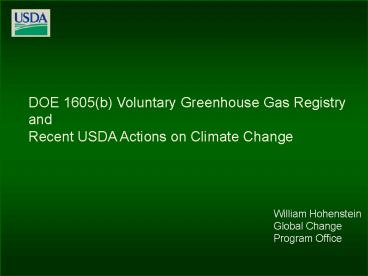Climate Change Briefing for Secretary Veneman - PowerPoint PPT Presentation
1 / 12
Title:
Climate Change Briefing for Secretary Veneman
Description:
The Secretary of Energy, In consultation with the Secretary of Commerce, the ... Enteric fermentation. Animal waste. Rice cultivation. Crop residue burning ... – PowerPoint PPT presentation
Number of Views:42
Avg rating:3.0/5.0
Title: Climate Change Briefing for Secretary Veneman
1
DOE 1605(b) Voluntary Greenhouse Gas Registry and
Recent USDA Actions on Climate Change
William Hohenstein Global Change Program Office
2
Directives to USDA
- The Secretary of Energy, In consultation with the
Secretary of Commerce, the Secretary of
Agriculture, and the Administrator of the
Environmental Protection Agency, to propose
improvements to the current voluntary emissions
reductions registration program under section
1605(b) of the 1992 Energy Policy Act - The Secretary of Energy to recommend reforms to
ensure that businesses and individuals that
register reductions are not penalized under
future climate policy and to give transferable
credits to companies that can show real
reductions - The Secretary of Agriculture, in consultation
with the Environmental Protection Agency and the
Department of Energy, to develop accounting rules
and guidelines for crediting sequestration
projects, taking into account emerging domestic
and international approaches - The Secretary of Agriculture,to develop new
targeted incentives for carbon sequestration and
greenhouse gas reductions.
3
Timeline for Final Review and Release of 1605b
Guidelines
Fall 04
- OMB review of proposed revised guidelines
- Public review of proposed revised guidelines
- --DOE public workshop
- --USDA public workshop on agriculture and
forestry guidelines - Release of revised 1605(b) guidelines
60 days
Winter 04-05
4
Importance for USDA
- Provides landowners with a tool to quantify and
record greenhouse gas benefits of actions such
as - Using no-till agriculture
- Installing a methane digester
- Improving nutrient management
- Managing forestland
- Provides opportunities for agriculture and
forestry to - Partner with industry
- Document benefits of actions for future use
- Link reporting with conservation programs, e.g.,
CSP
5
Components of Proposed Revised 1605(b) Guidelines
- General Guidelines
- Initial draft submitted for public comment
(12/03) - Technical Guidelines
- Chapter 1 Inventory guidelines
- Methods for quantifying sources and sinks of
greenhouse gases - Appendices with detailed coefficients and
protocols - Chapter 2 Guidelines for emission reduction
reporting - Methods for quantifying and registering
reductions in greenhouse gases - Forms and Instructions
- Electronic and hard copies being prepared
6
Features of the Revised DOE 1605(b) Voluntary
Greenhouse Gas Reporting System
- Overall quality of reported information will
improve - Consistent inventory methods. Inventory method
rating system to determine eligibility for
registration - Requirements in order to register reductions
- Large entities (emissions over 10,000 tons
CO2/yr) must report annual entity-wide
inventories of GHG emissions and sinks to be
eligible to register reductions - Small entities (emissions less than 10,000 tons
CO2/yr) can register reductions from specific
activities - Aggregators can report emissions and reductions
of other entities - Pre-2003 activities Only allow activities
beginning on 1/1/02 to be registered.
7
Reductions Can be Calculated as
- Changes in emissions intensity
- Changes in absolute emissions (if not resulting
from declines in output) - Changes in carbon storage
- Reductions Carbon stock year x - Carbon
stock base year - Changes in avoided emissions (resulting from
energy sales) - Action-specific emissions reductions (when other
methods are not appropriate/feasible) - Reductions associated with emission-free energy
8
USDA Contributions to the DOE 1605(b) Guidelines
- Inventory methods for agriculture sources
- Enteric fermentation
- Animal waste
- Rice cultivation
- Crop residue burning
- Nutrient and lime applications
- Inventory methods for agricultural soil carbon
sequestration - COMET model produces default sequestration
rates - Protocols for periodic sampling
- Inventory methods for forest and wood products
carbon stocks and fluxes - Default tables by region, species, management
intensity, productivity class - Measurement and sampling protocols
- Guidance on the use of models
- COLE model produces default forest carbon
sequestration rates - Methods for estimating reductions from carbon
sequestration
9
Issues Related to Forestry and Agriculture
- How does the system ensure that reductions are
maintained over time? - How to ensure that land owners cant receive
reductions by shifting practices? - Can simplified methods be developed for
sustainably managed forests? - Should landowners be responsible for natural
disturbances? - Can landowners receive reductions for forest
preservation? - How should carbon stored in wood products be
reported?
10
Next Steps
- Finalize guidelines!
- Technical Assistance and Outreach
- Demonstrations
- User-friendly manuals
- Training sessions
- Guidance to technical support providers
- Utilize USDA cooperators (i.e., extension
service, state conservationists, and field
offices) - Continue research to improve measurement,
monitoring, and verification
11
Greenhouse gases have been incorporated into USDA
Conservation Programs
- Environmental Quality Incentives Program (EQIP)
- NRCS provided national guidance to make GHG a
priority resource concern. - New practice standards for digesters announced in
2003. - Tiered payments under EQIP will reward producers
who improve nutrient management - Conservation Reserve Program (CRP)
- Secretary Veneman announced that USDA would
target 500,000 acres (226,000 ha) of bottomland
hardwoods under the CRP continuous sign-up - FSA providing points for carbon sequestration in
rating CRP proposals through the Environmental
Benefits Index (EBI). - Conservation Innovation Grants (CIG)
12
Greenhouse gases have been incorporated into USDA
Conservation Programs
- Conservation Security Program provides
incentives for energy conservation and renewable
energy production - 500/farm for energy audit.
- Energy savings from conservation tillage --
depends on level of reductions in soil
disturbance Index, fertilizer use, and over-all
energy use. - 2.50/100 kWh of energy produced by wind, solar,
geothermal and methane. - 125/500 gallons (one bio-component of liquid
fuel). - Renewable Energy Systems and Energy Efficiency
Improvements Program - Competitive grants for 167 recipients, including
35 manure digesters.































